There’s something undeniably magical about apple orchards. Rows of blossoming trees in spring, lush green canopies in summer, and crisp autumn days filled with ripe apples ready to be picked are more than just places where fruit grows.
They are spaces where nature, tradition, and human connection intertwine. For many, the apple orchard isn’t just about farming; it’s about harvesting memories that last a lifetime.
In this article, we’ll explore the beauty of apple orchards, the traditions tied to them, and the joy they bring to families and communities across generations.
🌸 The Charm of Apple Blossoms
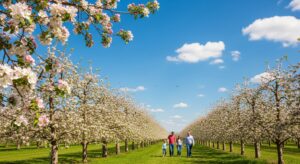
The orchard season begins long before harvest. In spring, apple trees burst into bloom with delicate pink and white flowers, filling the air with a sweet fragrance.
This enchanting sight often attracts visitors who come not just to admire the view but to take part in age-old traditions like blossom festivals.
Blossom time is more than a visual delight; it marks the start of the orchard’s yearly cycle. Pollinators, especially bees, play a critical role during this period, ensuring the blossoms transform into fruit later in the year.
Families walking through orchards in spring often remember the beauty of renewal and new beginnings.
🍎 Autumn Harvest: The Heart of the Orchard
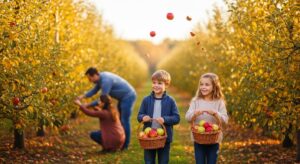
When fall arrives, apple orchards become vibrant landscapes of red, gold, and green. This is when the real magic happens, the harvest.
Families gather with baskets in hand, children climb ladders, and the orchard echoes with laughter. Picking apples isn’t just about gathering food; it’s about creating memories of togetherness.
For many, the tradition of visiting an orchard during harvest season is a yearly ritual that connects generations.
The smell of fresh apples, the crisp autumn air, and the simple joy of finding the perfect fruit make harvest season one of the most treasured parts of orchard life.
🥧 Orchard-to-Table Traditions

What happens after the harvest is just as memorable. Apple pies cooling on kitchen counters, jars of apple butter lining pantry shelves, or glasses of fresh cider being poured at family gatherings, these are the tastes of orchard life.
Generations pass down recipes that transform apples into more than just food. They become symbols of family heritage.
The process of cooking, baking, and preserving together creates shared experiences that bind families and communities.
🐝 Orchards as Ecosystems
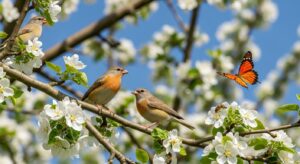
Apple orchards are more than fruit-producing spaces; they are thriving ecosystems. Birds nest among the branches, bees buzz through the blossoms, and beneficial insects help maintain balance.
For those who spend their lives tending orchards, there is a deep respect for the cycles of nature.
Planting cover crops, rotating soil, and integrating natural pest control are ways farmers keep orchards healthy while respecting the environment.
This close relationship with nature teaches orchard keepers lessons about patience, resilience, and sustainability.
🧺 Orchards and Family Bonds
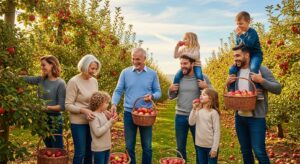
For many families, the orchard is where children learn their first lessons in responsibility and teamwork.
Helping to pick apples, caring for trees, or even running small orchard stands gives kids an appreciation for both nature and hard work.
Beyond family ties, orchards also bring communities together. Seasonal festivals, apple-picking events, and cider tastings turn orchards into gathering spaces where neighbors connect and celebrate.
The orchard becomes a backdrop for weddings, picnics, and seasonal traditions—a place where life’s milestones are celebrated among the trees.
📖 Memories Etched in Every Tree
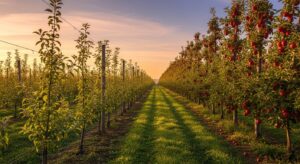
Each apple tree tells a story. Some were planted decades ago by ancestors, while others were added more recently to expand the orchard. Families often recall memories tied to specific trees where they first climbed, where they shared stories, or where they picked fruit for the first time.
These living landmarks become part of family history. Returning year after year to the same orchard brings comfort and continuity, especially in a world that’s constantly changing.
🌍 Lessons from Orchard Life
Living close to orchards teaches timeless lessons:
-
Patience – Trees take years before they bear fruit, reminding us that good things take time.
-
Resilience – Weather, pests, and challenges test farmers, but orchards endure.
-
Gratitude – Every harvest is a gift of nature’s generosity.
-
Community – Orchards thrive when people work together, from planting to harvesting.
These values extend far beyond the orchard, shaping how we live, work, and connect with others.
🍂 Conclusion: Harvesting More Than Apples
Life in the apple orchard isn’t only about cultivating fruit; it’s about cultivating memories, traditions, and relationships.
Every blossom, every harvest, and every family gathering contributes to a legacy that continues to grow with each season.
When we step into an orchard, we step into a space where nature and human connection blend seamlessly.
The apples we pick may be consumed in days, but the memories made in the orchard last a lifetime.
Truly, apple orchards are not just places of work or food production—they are places of joy, community, and love.
❓ 10 FAQs about Apple Orchard Life
1. Why are apple orchards so special to families?
Apple orchards are more than farms; they’re gathering spaces where families create traditions like apple-picking, picnics, and cooking recipes together.
2. When is the best time to visit an apple orchard?
The best time is autumn (September–October) during harvest, but spring blossoms are equally magical for festivals and photography.
3. What role do bees play in orchards?
Bees are essential pollinators, helping blossoms turn into apples. Without them, fruit production would drastically decline.
4. How do apple orchards support community life?
Orchards often host seasonal events, apple festivals, and cider tastings that bring neighbors and families together.
5. What are common orchard-to-table traditions?
Popular traditions include baking apple pies, making cider, creating apple butter, and preserving apples for winter.
6. How long does it take for an apple tree to bear fruit?
Depending on the variety, most apple trees take 3–5 years to start producing fruit after planting.
7. Are apple orchards environmentally sustainable?
Yes, many orchards use eco-friendly practices like crop rotation, cover crops, and natural pest control to maintain balance.
8. Why do people say orchards “teach patience”?
Because apple trees require years of growth before they bear fruit, orchards remind us that good things take time.
9. Can apple orchards be used for events like weddings?
Absolutely! Many orchards now host weddings, family reunions, and festivals because of their beautiful natural setting.
10. What makes orchard visits memorable for children?
Children enjoy climbing trees, picking apples, feeding animals, and helping with farm chores—activities that become cherished memories.